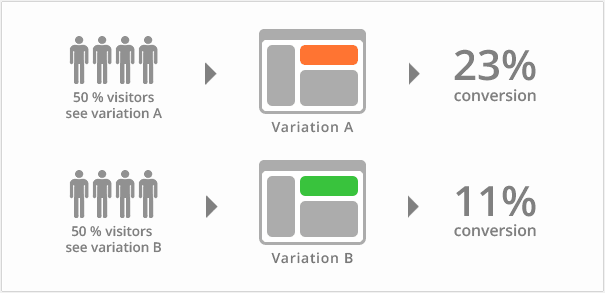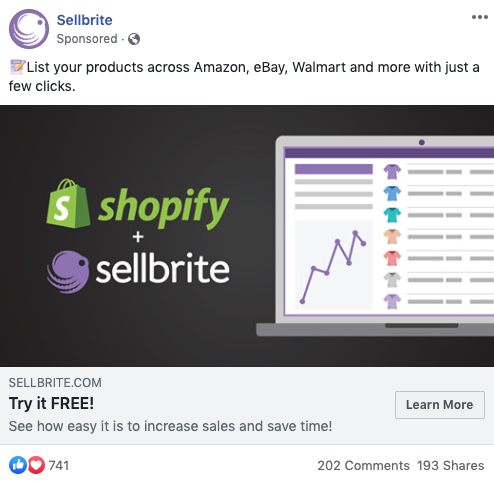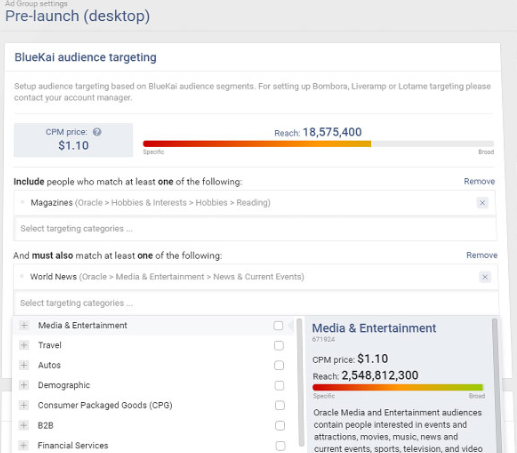The most successful B2B marketers spend 40% of their marketing budget on content marketing, according to a survey by the Content Marketing Institute.
Why are companies investing so much in this type of marketing? Because it works.
Seventy-two percent of marketers say content marketing increases engagement and number of leads. In fact, marketers rank content marketing as the top activity that’ll have the biggest impact on their business in the near future, according to Smart Insights.
Companies that don’t invest in content will face numerous challenges attracting an audience, maintaining that audience, enticing them to make a purchase, and more. This is why entrepreneur Gary Vaynerchuk says, “If you’re not putting out relevant content in relevant places, you don’t exist.”
It’s a simple, yet painfully honest and strikingly blunt claim intended to drive right into the heart of every business owner fighting for the attention of online consumers — including ecommerce companies. And it’s why ecommerce content marketing has become increasingly important in today’s competitive digital landscape.
Why You Need to Step up Your Ecommerce Content Marketing Game
As a business owner, you may have already heeded Gary Vaynerchuk’s warning and begun investing in content marketing.
You understand that consumers expect more from you than simply the product you sell them, and you know that creating and sharing valuable content doesn’t only engage consumers; it also builds trust among them. Plus, it helps you attract new buyers and potentially convert them into loyal customers.
However, your competitors know all of this as well. They all understand what content marketing is, they all have a blog, and they all create content for website visitors and social media followers.
Here’s the good news though: Much of competition has no idea what they’re doing, what types of content to focus on, how to get real ROI, or how to scale. They’re simply going through the motions and doing the bare minimum, so they can meet customers’ expectations when they land on their ecommerce website.
You can be better. You can also use content marketing to differentiate your business from your competitors, build brand loyalty, establish yourself as a thought leader in the industry, and drive more sales to your ecommerce business. And, most importantly, you can use that content to actually exceed consumers’ expectations.
This guide will help you do just that.
Important Terms in Content Marketing
There’s more to content marketing than just blogging every week. In order to take your content marketing efforts to the next level, you should become familiar with the following terms:
Analytics – The organization and evaluation of data in order to identify trends or patterns, uncover opportunities, track progress on goals and performance, and better understand user behavior. For example, a tool like Google Analytics can tell you which blog posts are sending the most people to your product pages and/or driving the most sales.
A/B Testing – Also known as split testing, this refers to the action of creating two different versions of a web component in order to influence behavior. For example, you can use a tool like KingSumo Headlines, Optimizely, or VWO to test different blog post headlines or opt-in forms on blog post pages.
Buyer Persona – A report that details the personality, demographics, hobbies, and lifestyle features of a typical customer. You can use buyer personas to come up with better blog post ideas. For example, you might write a blog post that addresses a specific pain point that most prospective customers have when deciding whether to buy your products.
Content Promotion – The act and art of sharing your content with new and current audiences on various places around the web in order to boost traffic, brand exposure, leads, and sales. You can promote content on social media sites like Facebook and Twitter, but you can also utilize email, industry forums, and influencers to help your content reach a wider audience.
Content Engagement – The opportunity to drive your followers or website visitors to engage in some sort of activity. This includes commenting on a blog post, sharing on social media, and retweeting a blog post.
Key Performance Indicator (KPI) – A metric to define success. For example, you can scale your content marketing efforts by setting goals relating to pageviews, time on site, click-through rate on emails, bounce rate, engagement rates, or sales.
Lead Generation – The act of looping a prospective customer into your sales funnel. In content marketing, this can be done by offering rich content, like an ebook, to visitors in exchange for their email address, as in the example below.
Link Building – The act of attempting to earn high-quality links from other websites that send new traffic to your website and influence your ranking in search results. You can earn links by developing compelling, original content and persuading other people and blog managers to share a link to your piece of content on their website.
Marketing Automation – The suite of software tools used to streamline tedious tasks, scale effective tactics, and automate processes. For example, you can set up an automatic email drip campaign that gets sent to each person who opts in to download an ebook or other resource offered on your blog.
Segmentation – To develop a specific strategy or specific content for a select subgroup within your customer base. For example, an ecommerce outdoors shop might decide to create a separate lead-nurturing email drip for customers who like hunting vs. customers who like hiking.
SEO – The practice of increasing the quantity and quality of traffic to your site through organic search results from search engines like Google. Learn more about SEO specifically for ecommerce sites in this guide from SpyFu.
10X Content – The idea that every piece of content you create and publish on your blog should be 10 times better than anything else that currently exists online about the same topic. Learn more about that here.
Ecommerce Content Marketing Do’s and Don’ts
To get more ROI from content marketing for your ecommerce business, make these best practices your own.
- Do set up tracking and run tests. Content marketing metrics matter because you can’t scale what you don’t track. To boost content marketing success, set up tracking using Google Analytics, which will allow you to analyze everything from pageviews and time on site to bounce rate and audience demographics. It’s also a good idea to run A/B tests with a tool like Optimizely.
- Don’t expect results right away. Content marketing takes time. In fact, it can take six to nine months investing consistently in blogging, paid advertising, promotion, and lead generation before you start seeing results from ecommerce content marketing.
- Do be willing to spend more for better content. You get what you pay for. If you’re not willing to spend top dollar on writers, don’t expect to get good content. Looking for a resource to find writers for your ecommerce content marketing? Check out Scripted.
- Don’t be spammy. Your goal as an ecommerce business is obviously to sell more products. But when it comes to content marketing, don’t go overboard including special offers, coupons, and deals in your content. At the end of the day, if you can provide value and position yourself as a resource that people can trust, then the sales will come.
- Do Facebook advertising. Facebook advertising can be an incredibly useful platform for promoting content and connecting with the right audience. There’s a lot you can do with segmenting down to your exact target audience. Learn how to drive ROI with Facebook ads.
- Don’t try to do everything yourself. If you want to scale your content marketing efforts and continue to boost ROI, you have to be willing to delegate tasks and use tools to boost productivity. Several useful ecommerce content marketing tools are outlined below.
- Do listen to customers. Use tools like Intercom, Google Forms, or Facebook polls to find out what kind of content your customers want to read on your blog. It’s a lot better than assuming you know all the questions your customers have about your products and industry and creating content that neither helps nor interests them.
- Don’t be like everyone else. Don’t copy your competitors. Be original. If you can google your blog post idea and find more than three blog posts already covering your topic, it’s probably not worth writing about — unless you are confident you can make your blog post 10x better than anything else that exists.
- Do create personas for your content marketing. Take the time to learn more about your ideal customer and organize information into buyer personas and blog reader personas. Learn how to build buyer personas for better marketing in this guide from Shopify.
- Don’t over-automate. It’s important to streamline tasks with tools, but be careful not to come across as too robotic in your blog posts, social media updates, and emails. At the end of the day, your customers still want to feel like they’re doing business with a human being, so make sure you keep a good amount of personality and authenticity in your content.
Content Marketing Resources
The best way to advance your content marketing skills is to learn from the experts — people who are pumping out fresh content, new ideas, and proven tactics each and every day. Here are some great resources to start with.
Why Good Unique Content Needs to Die – Rand Fishkin, Moz
In this video, SEO master and content guru Fishkin introduces the idea of “10x-ing” content. It’s a great presentation to help you understand how SEO has changed and why meeting the minimum expectations in terms of content quality just doesn’t cut it anymore.
100+ Ways to Promote Your Content – Sujan Patel, Content Marketer
Most businesses are investing in content marketing and blogging, but few are actually dedicating resources to content promotion. In this blog post, content marketing expert Patel outlines 100+ proven content promotion tactics and sources that you can use to boost brand exposure and bring more potential customers to your website.
How To Boost Conversions by 785% in One Day – Brian Dean, Backlinko
In this blog post, SEO guru Dean introduces the “content upgrade,” an incredibly effective lead-generation tactic that you can incorporate into your blog content to capture subscribers and move them through your sales funnel.
I Just Deleted Your Outreach Email Without Reading. And NO, I Don’t Feel Sorry. – Tim Soulo, Ahrefs
In this post, Soulo outlines exactly what you shouldn’t do when promoting content in emails. It’s full of tips to help you write better, more-effective outreach emails.
Why You Need a Growth Model For Your Blog (And How to Create One) – Devesh Khanal, Grow and Convert
If you’re really interested in scaling your blog to drive sales, this blog is definitely worth diving into. It’s heavy on data and metrics, but it’s incredibly useful. In it, CRO expert Khanal lays out a framework for fueling blog growth.
Here Are The 101 Catchy Blog Title Formulas That Will Boost Traffic By 438% – Nathan Ellering, CoSchedule
This blog post will teach you how to write better titles for your blog posts. It’ll teach you how to use the four pillars of awesome content in your blog titles, how to employ psychology to increase shares and clicks, and the best words to capture your audience’s unique interest.
Building a Content Team: Hiring In-house vs. Outsourcing vs. Hiring Freelancers – Benji Hyam, Grow and Convert
In this blog post, author Benji Hyam presents the pros and cons of hiring in-house content writers vs. hiring freelancers. It’s a great post to go through once you start experiencing some initial traction on your blog and want to scale your efforts.
How the Pros Track Conversions and ROI With These Content Marketing Metrics – Aaron Agius, Louder.online
Agius walks you through how to calculate a few of the top metrics for interpreting the success of your content marketing. Your evaluation needs to go beyond pageviews and social shares and include metrics like customer lifetime value and revenue per page view.
24 Juicy Tips for Ecommerce Content Marketing from Inbound Marketing Pros – Desmond Chua, ReferralCandy
In this infographic-style blog post, Chua presents 24 helpful content marketing tactics for ecommerce content marketing. He sources the tips in his blog post from some of the best and brightest internet marketing professionals in the business.
Content Marketing Influencers to Follow
To level up your content marketing skills and constantly stay ahead of the game, read content from and follow these content marketing influencers:
Sujan Patel – Growth marketer, author, entrepreneur, and founder of Milkshake
Brian Honigman – Content marketing consultant, author, and founder of Honigman Media
Joanna Wiebe – Master copywriter, blogger, and creator of Copyhackers
Jay Baer – Digital marketer, author, speaker, and founder of Convince & Convert
Camille Ricketts – Head of marketing at Notion
Neil Patel – Internet marketing guru, entrepreneur, content marketing blogger, and founder of CrazyEgg
Rob Wormley – Head of content marketing at When I Work, author of the Content Marketing Playbook and 100 Days of Growth
Brian Dean – SEO guru, content marketing blogger, and founder of Backlinko
Rand Fishkin – SEO master, content marketing blogger, and founder of Moz
Jimmy Daly – Vice president of growth at Animalz, an agency that provides high-end content marketing solutions to SaaS and tech companies
William Harris – Growth marketer, entrepreneur, content marketing blogger – and author of this post
Best Tools for Ecommerce Content Marketing
If you want to focus on advancing your content marketing skills and increasing ROI, you have to start outsourcing tasks and adopting tools. Here are a handful that you can start with:
Alexa – Audience research is a must. Alexa lets you dig into your target audience — see their interests, where they spend their time online, the keywords they use when they’re ready to buy, which other brands they consider, and much more.
Buffer – Buffer is my go-to tool for sharing content on social media. With Buffer, you can write and schedule posts for later, track engagement, conversions, and trends, and collaborate with team members.
BuzzSumo – A content discovery and research tool that helps generate better blog post ideas. It allows you to quickly analyze what content performs best for any topic or competitor online. You can also use it to find influencers and highly active social media users who can help you get the word out about your content and products. You can even use BuzzSumo to track competitors.
Canva – Canva is an easy-to-use tool for non-designers to create original graphics. You can use Canva-created images to visually summarize parts of a blog and for social media promotions.
CoSchedule – CoSchedule is a powerfully simple editorial calendar plugin that runs on WordPress. It’s a great alternative to Excel spreadsheets and other clunky solutions. With CoSchedule, you can collaborate with your team through the use of comments, tasks, and customized workflows. You can also create content from within the tool, or you can work from within WordPress or another tool like Google Docs or Evernote. When you’re ready to publish the post, CoSchedule can even schedule and promote your posts.
Curalate – Curalate empowers ecommerce businesses to drive engagement, traffic, and revenue with images across every consumer touchpoint. It takes your content, as well as user- and influencer-generated content, and employs it in creative ways to aid in discovery and make the ecommerce shopping experience more like browsing in a brick-and-mortar store.
Facebook Ads – As mentioned earlier, Facebook ads can be an incredibly effective tool for getting your content and products in front of your target audience. You can use Facebook ads to automatically promote relevant products and content to website visitors, current customers, and look-alike audiences.
Google Keyword Planner – This is an effective tool for doing keyword research to come up with new blog post ideas. When you create blog posts based on specific long-tail keyword phrases that people are typing into Google, you have a better chance of showing up in search results.
Sumo– Sumo is a suite of tools that make it incredibly easy to design and launch email opt-in forms on your website. For example, you can use the tool to create a form that blog visitors can fill out in order to gain access to an ebook or worksheet. You could also use the Sumo Welcome Mat to start building a list of subscribers that you can email each time you publish new content.
Trello – Trello is a visually focused project management tool that makes it easy to plan your entire content calendar and work with blog posts from the idea all the way to the published product. You can use the tool to create to-do’s, communicate with freelance writers, attach documents, assign due dates, and integrate with other tools like Google Drive, Dropbox, and more.
Zemanta – Zemanta, illustrated above, is a paid content-distribution tool. It’s a service that you can use to place your content on other popular sites and blogs around the web to reach more people who may be interested in your products. Like Facebook ads, it has powerful demographic and segmentation tools that allow you to really zero in on the right audience.
Turn Readers into Buyers
The average ecommerce conversion rate is only 1-3%, so ecommerce brands need to find ways to not only capture consumers’ attention but also maintain it. That’s where ecommerce content marketing comes in.
Producing consistent, quality content and sharing it widely will help your ecommerce brand attract and engage an audience — and that’ll increase the chances of turning a reader into a buyer.









31 thoughts on “Ecommerce Content Marketing: The Advanced Guide”
Thanks for including me in this insightful piece William, I appreciate it. Keep it up. ?
Anytime, Brian – I’ve been following your work in content marketing for a while. You’ve been a big inspiration.
Thanks for including me in this insightful piece William, I appreciate it. Keep it up. ?
Anytime, Brian – I’ve been following your work in content marketing for a while. You’ve been a big inspiration.
Thanks for including me in this insightful piece William, I appreciate it. Keep it up. ?
Anytime, Brian – I’ve been following your work in content marketing for a while. You’ve been a big inspiration.
Really great piece, William! Tons of actionable takeaways here.
Thanks, Amlan – glad you liked it.
Really great piece, William! Tons of actionable takeaways here.
Thanks, Amlan – glad you liked it.
Really great piece, William! Tons of actionable takeaways here.
Thanks, Amlan – glad you liked it.
Have to put relevant content in relevant place. Nice write up.
Thanks Classi 🙂 Relevancy is often overlooked.
Have to put relevant content in relevant place. Nice write up.
Thanks Classi 🙂 Relevancy is often overlooked.
Have to put relevant content in relevant place. Nice write up.
Thanks Classi 🙂 Relevancy is often overlooked.
Stellar summary, Will. So many helpful tools and definitions. I’ll be coming back to this one for sure.
Hey, Aaron – thanks! Big fan of your work as well!
Stellar summary, Will. So many helpful tools and definitions. I’ll be coming back to this one for sure.
Hey, Aaron – thanks! Big fan of your work as well!
Stellar summary, Will. So many helpful tools and definitions. I’ll be coming back to this one for sure.
Hey, Aaron – thanks! Big fan of your work as well!
Awesome to be included with such esteemed company, and in such a useful, thorough list! This is great.
Hey Visakan – ReferralCandy is great!
Awesome to be included with such esteemed company, and in such a useful, thorough list! This is great.
Hey Visakan – ReferralCandy is great!
Awesome to be included with such esteemed company, and in such a useful, thorough list! This is great.
Hey Visakan – ReferralCandy is great!
Great piece of writing!!Content is the King It was true and It will true forever. Thanks for giving this amazing article.